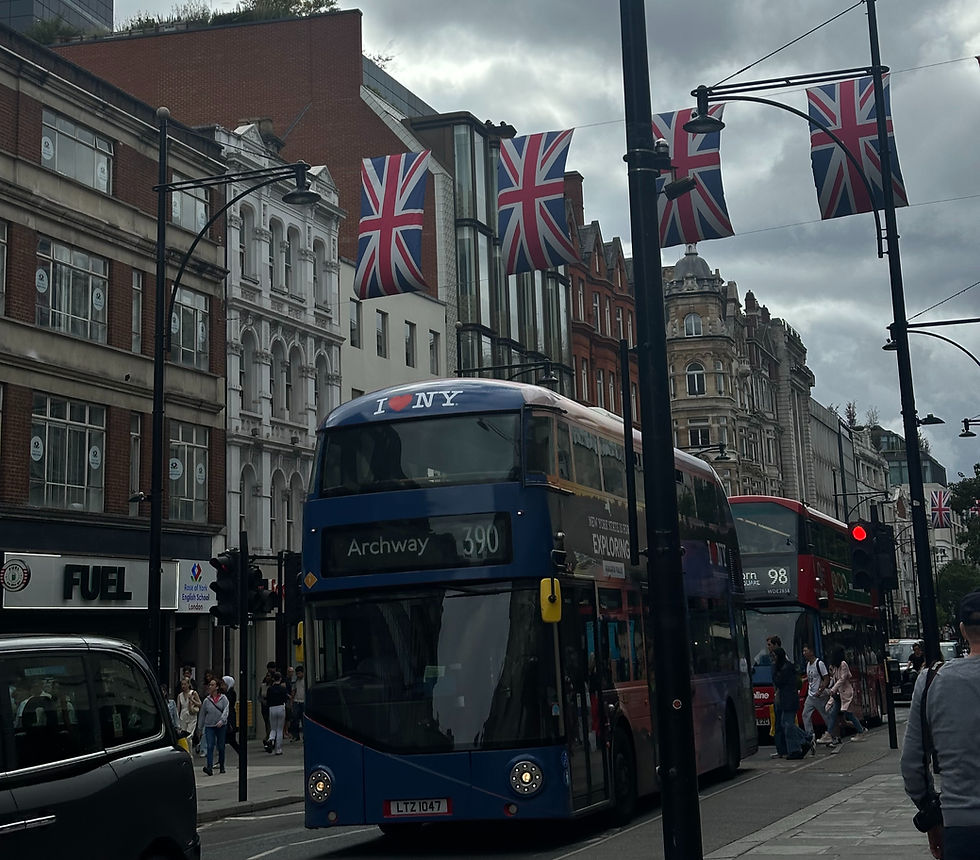London Street, NY Day
- Catherine Shen
- Oct 23
- 3 min read
Updated: 5 days ago

Hello, my fellow flaneurs and flâneuses,
Today, we begin with the thought process behind the blog's title, "London Street, NY Day," which refers to the French painter Gustave Caillebotte's painting, "Paris Street, Rainy Day." "Paris Street, Rainy Day" is another work that revolves around the concept of the flaneur, conveying a quiet commentary on the disconnection of modern life, the blurring of connections, and the rain blurring vision.

The blog title "London Street, NY Day" is a juxtaposed commentary on the original piece, reflecting how modern society has made individuals more disconnected from one another. Instead, this image shows how, no matter how far away I am, I can always find a piece of home—I ♥️ NY.
Walking through the layout of London reminds me of New York City, or should it be the other way around, since much of the US is named after its British locations due to its history as an English colony? Still, I digress (New York is the better version anyway.) From the layout of Soho, Chinatown, and Piccadilly Circus to the uncanny similarities of Chelsea to Chelsea and Shoreditch to Williamsburg, I am in a home away from home.
London Fashion Districts
Walking around, you can easily sense their target demographic by exploring the London fashion districts—Oxford Street, Regent Street, Carnaby Street, and Bond Street, from the mass marketing of Oxford Street to the luxury consumers of Bond Street.
With its mass commercial appeal at the epicenter of London shopping, Oxford Street is similar to Herald Square and Times Square, characterized by bustling crowds, a diverse demographic, and a focus on fast fashion. Oxford Street is where you can find Zara, H&M, and large department stores like Selfridges. This mirrors Midtown Manhattan, with Macy's—the largest Macy's in the world—and Zara, H&M, and other fast-fashion stores, all designed for high foot traffic. Both areas represent fashion accessibility, volume, and the masses. Nevertheless, the difference between the two places is that Oxford Street is more organized and European-leaning in its aesthetic—which makes sense—and Midtown is louder, brighter, and unapologetically New York.
Regent Street changes things just a few blocks with its stylish architecture and a shopping vibe about experiences and high-end brands. You'll find flagship stores for big names like Apple, On Cloud, and Arket, mixing classic charm with modern looks. Shopping here feels a bit fancier than on Oxford Street. It has that Soho feel, with many flagship stores and similar-looking buildings.
Home to the 1960s fashion revolution, Carnaby Street features underground music venues, independent clothing shops, and a young, trendy fashion scene, all of which still reflect its historical past. The street is filled with indie, vintage, and hipster stores, drawing from its origins for its unique visual marketing. This aligns with the Lower East Side, where it shares brands like Supreme and stores similar to NYC's Komune and London's END. Like London's indie boutiques, New York's smaller concept stores thrive on individuality and authenticity.
Bond Street, London's luxury center. The polished window displays a quiet atmosphere, contrasting with the bustling streets of Oxford Street. You will find heritage luxury brands such as Chanel, Dior, Chopard, and more here. Here, client relations are key, where the air smells faintly of perfume, with its changing brand signatures, utilizing scent marketing to immerse the buyer in the atmosphere deliberately. Bond Street mirrors Madison Avenue and Fifth Avenue, where the boutiques operate as art galleries for these pieces of art, presenting them to their buyers.
Exploring Uniqlo
Uniqlo's flagship stores in London and New York showcase its ability to adapt its minimalist approach to different cultures. The Fifth Avenue location in New York is a fast-paced environment, designed for efficiency, which allows shoppers to find their sizes and continue shopping quickly. In contrast, the Regent Street store in London offers a more intentional experience, inviting customers to linger and engage with the clothing, making shopping an exploration rather than a rush. Both stores sell the same "LifeWear" concept. Yet, they present it in ways that reflect their respective city lifestyles, highlighting how Uniqlo embodies distinct cultural nuances while delivering a unified core message.
Exploring both cities, we realize that fashion transcends boundaries and isn't just about what you wear, but also about where you walk. The street becomes the runway, and the city's layout becomes a map of how we consume, dream, and express ourselves through style.
XOXO till next time, my fellow flâneurs~

Comments